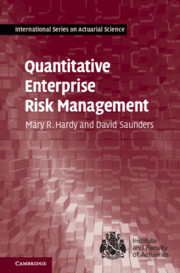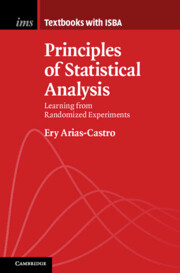Refine search
Actions for selected content:
2703 results in General statistics and probability
Frontmatter
-
- Book:
- Principles of Statistical Analysis
- Published online:
- 22 July 2022
- Print publication:
- 25 August 2022, pp viii-viii
-
- Chapter
- Export citation
16 - One Numerical Sample
- from Part III - Elements of Statistical Inference
-
- Book:
- Principles of Statistical Analysis
- Published online:
- 22 July 2022
- Print publication:
- 25 August 2022, pp 230-270
-
- Chapter
- Export citation
Preface
-
- Book:
- Principles of Statistical Analysis
- Published online:
- 22 July 2022
- Print publication:
- 25 August 2022, pp xiv-xvi
-
- Chapter
- Export citation

Quantitative Enterprise Risk Management
-
- Published online:
- 28 July 2022
- Print publication:
- 05 May 2022
-
- Textbook
- Export citation

Principles of Statistical Analysis
- Learning from Randomized Experiments
-
- Published online:
- 22 July 2022
- Print publication:
- 25 August 2022
Frontmatter
-
- Book:
- The Fundamentals of Heavy Tails
- Published online:
- 17 May 2022
- Print publication:
- 09 June 2022, pp i-iv
-
- Chapter
- Export citation
Part I - Properties
-
- Book:
- The Fundamentals of Heavy Tails
- Published online:
- 17 May 2022
- Print publication:
- 09 June 2022, pp 27-28
-
- Chapter
- Export citation
Part III - Estimation
-
- Book:
- The Fundamentals of Heavy Tails
- Published online:
- 17 May 2022
- Print publication:
- 09 June 2022, pp 175-176
-
- Chapter
- Export citation
7 - Extremal Processes
- from Part II - Emergence
-
- Book:
- The Fundamentals of Heavy Tails
- Published online:
- 17 May 2022
- Print publication:
- 09 June 2022, pp 148-174
-
- Chapter
- Export citation
1 - Introduction
-
- Book:
- The Fundamentals of Heavy Tails
- Published online:
- 17 May 2022
- Print publication:
- 09 June 2022, pp 1-26
-
- Chapter
-
- You have access
- Export citation
References
-
- Book:
- The Fundamentals of Heavy Tails
- Published online:
- 17 May 2022
- Print publication:
- 09 June 2022, pp 240-248
-
- Chapter
- Export citation
2 - Scale Invariance, Power Laws, and Regular Variation
- from Part I - Properties
-
- Book:
- The Fundamentals of Heavy Tails
- Published online:
- 17 May 2022
- Print publication:
- 09 June 2022, pp 29-55
-
- Chapter
- Export citation
6 - Multiplicative Processes
- from Part II - Emergence
-
- Book:
- The Fundamentals of Heavy Tails
- Published online:
- 17 May 2022
- Print publication:
- 09 June 2022, pp 127-147
-
- Chapter
- Export citation
Part II - Emergence
-
- Book:
- The Fundamentals of Heavy Tails
- Published online:
- 17 May 2022
- Print publication:
- 09 June 2022, pp 105-106
-
- Chapter
- Export citation
9 - Estimating Power-Law Tails: Let the Tail Do the Talking
- from Part III - Estimation
-
- Book:
- The Fundamentals of Heavy Tails
- Published online:
- 17 May 2022
- Print publication:
- 09 June 2022, pp 197-237
-
- Chapter
- Export citation
Acknowledgments
-
- Book:
- The Fundamentals of Heavy Tails
- Published online:
- 17 May 2022
- Print publication:
- 09 June 2022, pp xiii-xiv
-
- Chapter
- Export citation
4 - Residual Lives, Hazard Rates, and Long Tails
- from Part I - Properties
-
- Book:
- The Fundamentals of Heavy Tails
- Published online:
- 17 May 2022
- Print publication:
- 09 June 2022, pp 85-104
-
- Chapter
- Export citation
8 - Estimating Power-Law Distributions: Listen to the Body
- from Part III - Estimation
-
- Book:
- The Fundamentals of Heavy Tails
- Published online:
- 17 May 2022
- Print publication:
- 09 June 2022, pp 177-196
-
- Chapter
- Export citation
Contents
-
- Book:
- The Fundamentals of Heavy Tails
- Published online:
- 17 May 2022
- Print publication:
- 09 June 2022, pp v-viii
-
- Chapter
- Export citation
Preface
-
- Book:
- The Fundamentals of Heavy Tails
- Published online:
- 17 May 2022
- Print publication:
- 09 June 2022, pp ix-xii
-
- Chapter
- Export citation
